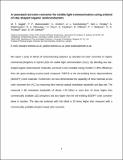Files in this item
A saturated red color converter for visible light communication using a blend of star-shaped organic semiconductors
Item metadata
| dc.contributor.author | Sajjad, Muhammad Tariq | |
| dc.contributor.author | Manousiadis, Pavlos | |
| dc.contributor.author | Orofino, Clara | |
| dc.contributor.author | Kanibolotsky, Alexander | |
| dc.contributor.author | Findlay, Neil | |
| dc.contributor.author | Rajbhandari, Sujan | |
| dc.contributor.author | Vithanage, Chiranthika Dimali Amarasinghe | |
| dc.contributor.author | Chun, Hyunchun | |
| dc.contributor.author | Faulkner, Graham | |
| dc.contributor.author | O'Brien, Dominic | |
| dc.contributor.author | Skabara, Peter | |
| dc.contributor.author | Turnbull, Graham Alexander | |
| dc.contributor.author | Samuel, Ifor David William | |
| dc.date.accessioned | 2016-11-25T10:30:15Z | |
| dc.date.available | 2016-11-25T10:30:15Z | |
| dc.date.issued | 2017-01 | |
| dc.identifier | 247958738 | |
| dc.identifier | 8f82c092-97be-4535-842e-4cda5eae83f3 | |
| dc.identifier | 000392834600042 | |
| dc.identifier | 85009074889 | |
| dc.identifier | 000392834600042 | |
| dc.identifier.citation | Sajjad , M T , Manousiadis , P , Orofino , C , Kanibolotsky , A , Findlay , N , Rajbhandari , S , Vithanage , C D A , Chun , H , Faulkner , G , O'Brien , D , Skabara , P , Turnbull , G A & Samuel , I D W 2017 , ' A saturated red color converter for visible light communication using a blend of star-shaped organic semiconductors ' , Applied Physics Letters , vol. 110 , no. 1 , 013302 . https://doi.org/10.1063/1.4971823 | en |
| dc.identifier.issn | 0003-6951 | |
| dc.identifier.other | ORCID: /0000-0001-8678-9126/work/47136532 | |
| dc.identifier.other | ORCID: /0000-0001-6457-3236/work/60427398 | |
| dc.identifier.other | ORCID: /0000-0002-2132-7091/work/31037439 | |
| dc.identifier.uri | https://hdl.handle.net/10023/9877 | |
| dc.description | Authors would like to acknowledge the EPSRC for financial support for the UP-VLC (EP/K00042X/1). PJS and IDWS also acknowledge Royal Society Wolfson Research Merit Awards. | en |
| dc.description.abstract | We report a study of blends of semiconducting polymers as saturated red color converters to replace commercial phosphors in hybrid LEDs for visible light communication (VLC). By blending two star-shaped organic semiconductor molecules, we found a near complete energy transfer (> 90% efficiency) from the green-emitting truxene-cored compound T4BT-B to the red-emitting boron dipyrromethene (BODIPY) cored materials. Furthermore, we have demonstrated the capability of these materials as fast color converters for VLC by measuring their intrinsic optical modulation bandwidth and data rate. The measured 3 dB modulation bandwidth of blends (~55 MHz) is more than 10 times higher than commercially available LED phosphors and also higher than the red-emitting BODIPY color converter alone in solution. The data rate achieved with this blend is 20 times higher than measured with a commercially available phosphor based color converter. | |
| dc.format.extent | 4 | |
| dc.format.extent | 1106988 | |
| dc.language.iso | eng | |
| dc.relation.ispartof | Applied Physics Letters | en |
| dc.subject | WHITE-LIGHT | en |
| dc.subject | QB Astronomy | en |
| dc.subject | QC Physics | en |
| dc.subject | TP Chemical technology | en |
| dc.subject | DAS | en |
| dc.subject.lcc | QB | en |
| dc.subject.lcc | QC | en |
| dc.subject.lcc | TP | en |
| dc.title | A saturated red color converter for visible light communication using a blend of star-shaped organic semiconductors | en |
| dc.type | Journal article | en |
| dc.contributor.sponsor | EPSRC | en |
| dc.contributor.institution | University of St Andrews. School of Physics and Astronomy | en |
| dc.contributor.institution | University of St Andrews. Condensed Matter Physics | en |
| dc.identifier.doi | https://doi.org/10.1063/1.4971823 | |
| dc.description.status | Peer reviewed | en |
| dc.identifier.grantnumber | EP/K00042X/1 | en |
This item appears in the following Collection(s)
Items in the St Andrews Research Repository are protected by copyright, with all rights reserved, unless otherwise indicated.

